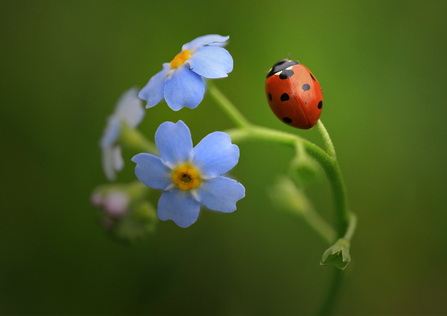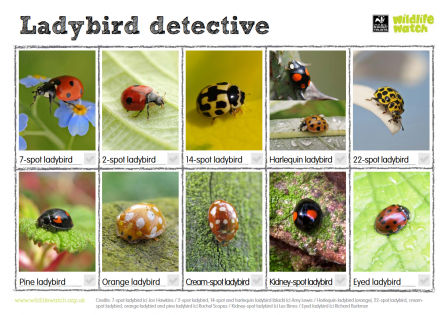Seven-spot ladybird by Jack Perks
All about ladybirds
Seven spot ladybird by Jon Hawkins - Surrey Hills Photography
Ladybirds are one of the first insects we learn to recognise and love when we are children, so very familiar with their bright red and black markings. They are celebrated with a children’s rhyme and gardeners welcome them for their ability to control greenfly.
But what do you really know about them?
Ladybirds are beetles, which means they have two wings which have been modified to make hard wing cases. These colourful covers protect their body and also hide a second pair of membranous wings that they fly with.

7-spot ladybird by Jon Hawkins/Surrey Hills Photography
There are 47 species of ladybird in the UK, some are rare, but many can be found in gardens. The most familiar (and common) is the 7-spot ladybird with three black spots on each wing case and one centrally near the head. The harlequin is also very common but more difficult to identify as it has many different colour variations which people may mistake for different species. Several other species have more than one colour variation too, so care is needed when identifying an unfamiliar ladybird.
A group of harlequin ladybirds, showing different of colour variations. Photo by Mick Jones
Until 2003 no one had seen a harlequin ladybird in the UK and probably the most common garden ladybird was the 2-spot ladybird, since then the harlequin has spread and the 2-spot has declined, either through competition for food or because the harlequin will eat ladybird larvae. But the 2-spot may be increasing again, only time will tell.
Both the 7-spot and harlequin are fearsome and efficient predators of small invertebrates, mainly greenfly, which they consume in large quantities both as adults and larvae.
7-spot ladybird larva by Les Bins
Talking of larvae, be careful what you squash! People tell me they have found horrid, ugly bugs which they want to get rid of, until I reveal they are ladybird larvae and incredibly useful to the gardener. Beauty is in the eye of the beholder!
In my garden if we find blackfly all over the runner beans (or other crops), we simply wait and soon the ladybirds find the aphids, lay eggs and then adults and larvae alike proceed to munch all the aphids. After a week or so when they run out of prey they simply fly off to help another gardener or farmer.
A group of 16-spot ladybirds. Photo by Sue Taylor
Not all ladybirds are red and black, others are yellow and black, or orange and white, these bright colours warn predators they are nasty to eat and so protect the ladybirds from becoming lunch. But there are yet more species which are brown and hairy, and often very small, these are the ‘inconspicuous’ ladybirds and may be found lurking in trees or ivy.
Most of our ladybirds feed on aphids or scale insects, but some are vegetarian feeding on fungi, algae, or pollen. A few ladybirds eat leaves, the bryony ladybird eats a wild flower called white bryony, while the diminutive 24-spot eats grasses.
We have two species in the UK that live in ant nests, living on the aphids that the ants are farming on plant roots. One of these species the appropriately named ant-nest ladybird (Platynaspis luteorubra) is a rare species which has recently been found on the new extension land at Dancersend Nature Reserve. Its presence is a sign that BBOWT’s careful management to encourage a rich grassland habitat here is working well.
Adonis ladybird. Photo by Sue Taylor
The Adonis ladybird, another uncommon species, likes open disturbed soils and has been found in the arable weed areas at Grangelands, one of a range of uncommon insects associated with disturbed arable ground that is free of pesticides.
Unlike many insects ladybirds may be found all year, with many overwintering as adults, though when it is cold they will be tucked away against the worst of the weather only emerging with the sunshine. So even in winter you stand a chance of seeing a splash of welcome colour.
If you want to know more about ladybirds there is an excellent book the 'Field guide to ladybirds of Britain and Ireland’ by Helen Roy and Peter Brown, illustrated by Richard Lewington, or you can download the ‘iRecord Ladybirds’ app for free.
There are also two excellent YouTube webinars from the UK Centre for Ecology and Hydrology by Helen Roy and Peter Brown these are a real help with the identification of adults and larvae.
So next time you see a ladybird, pause and take a good look at this charming and helpful little beetle.
Sue Taylor
(Volunteer recorder for BBOWT, focusing on entomology)
See if you can spot these different ladybirds

Ladybirds are just one family of the many different types of beetle.
Download your FREE guide to bringing back beetles in your own garden to learn more about lots of different kinds of beetles and how to help them, including instructions for building your very own beetle bucket, beetle bank, or dead hedge.

